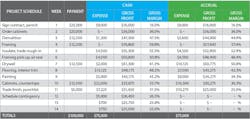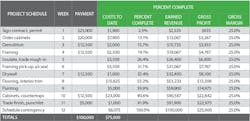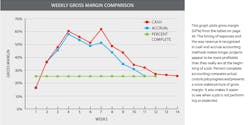Is It Your Money? The 'Percent Complete' Method to Track Revenue
Remodelers from around the country tell me that things are good. The phone constantly rings with new leads and backlogs build. They can’t look at a job until August and can’t start till December (and who starts in December?). Money flows, and big, new trucks drive off the lots. In fact, total vehicle sales were led by truck sales from the big three (Ford, followed by Chevy and Dodge).
As a remodeling contractor, you may have more money in your pockets now than in recent years. But is it really your money? How do you know? Cash in the bank tells you nothing; neither do the accounts receivable balance or available lines of credit. There’s only one answer, and it lies in understanding a construction-specific accounting method called Percent Complete (PC).
Simply put, percent complete accounting calculates earned revenue based on job costs to date. Regardless of how much you’ve received in deposits or billed and been paid by clients, you’ve only truly earned job costs plus any agreed upon overhead and profit.
What Counts as Revenue?
Let’s back up a bit to Accounting 101 and look at how three different accounting methods “recognize” revenue.
1. Cash. A client’s check becomes income when you deposit it, and a job cost becomes an expense when you pay the bill for it. The formula for cash-based gross profit is:
Cash income minus cash job cost
Cash accounting is sometimes called “checkbook accounting,” and while it is perfectly OK to use it to pay taxes, it can get you into financial hot water if you use it to keep track of revenue. We’ll see why and how in a minute.
2. Accrual. Income is recognized when the invoice is sent to the client, and a job cost becomes an expense when the cost is incurred or when the invoice from a trade contractor or vendor is received. The formula for accrual-based gross profit is:
Accrued income (receivables) minus accrued expense (payables)
Accrual accounting isn’t perfect, but even with its shortcomings, it’s better than cash accounting for longer projects.
3. Percent Complete. Here the formula for gross profit is:
Earned income (calculated) minus accrued expense
This is really the only method you should use for jobs lasting longer than six weeks because it shows the true gross profit of jobs in progress and of the overall company throughout the year.
Head-to-Head Comparison
To show why the percent complete approach does so much better as a financial management tool, let’s use each of the three accounting methods to follow the progress of gross profit dollars and percentages through a typical kitchen remodel lasting three months (see “Three Accounting Methods Compared,” opposite). We’ll assume estimated costs of $75,000 (not including owner-supplied appliances) and a contract price of $100,000. The job is scheduled over 12 weeks, with seven payments keyed to progress milestones.
The scheduled payments are front loaded to push more income to the early part of the job. This allows the remodeler to work using the client’s money more than halfway through the project. (In this hypothetical job, the front-loading is somewhat exaggerated to emphasize the differences in the three accounting methods.)
Expenses, however, can’t be as predictably scheduled as payments. Labor is paid twice monthly in this scenario, but just as timing affects the recognition of revenue (as explained above), the timing of trade contractor and material expenses depends on the accounting method used.
Cash. Trade contractor invoices are paid when received and material invoices are paid at the beginning of the following month (to take advantage of any discounts).
Accrual. Invoices from trade contractors and material suppliers are posted to accounts payable when received. Trade invoices are paid within a week of being received (to keep the subcontractors happy), and supplier invoices are paid at the beginning of the following month to take advantage of discounts.
Percent Complete. Trade contractor invoices are posted in the month in which the work was done; supplier invoices are posted in the month that the materials were ordered.
Now let’s pull back the curtain to see how these differences affect the accuracy of financial and job cost reporting, and to answer the question, “Is it your money?” Although in the end, all methods show a gross margin of 25 percent, a remodeler relying on early reports using the cash or accrual method may have made some terrible decisions. But look at the numbers that the percent complete method reports. The gross profit margin is correct week to week according to the original estimate of 25 percent.
The Cash and Accrual methods:
The Percent Complete method:
The cash method recognizes income when checks are deposited, and expenses when bills are paid. The accrual method recognizes revenue when bills are created, and expenses when bills are received. In both methods, the deposit and front-loaded payments paint a misleading picture of how profitable the job-in-progress is. This often leads contractors to assume that they are making more money than expected, which can lead to poor financial decisions. Notice, also, that using the cash method, true margin is not available for two weeks after the job has ended.
The percent complete method compares estimated expenses to actual costs put into the job-in-progress, then calculates revenue based on what percentage of the total job is finished. So long as the job progresses according to plan, gross profit margin remains stable.
Why Percent Complete Works
How is that possible? The “trick” to the percent complete calculation lies primarily in the accuracy of three variables:
Accurate pricing. The contract price and project budget or estimate must account for the company’s target margin. (In these examples, a 1.33 markup yields a 25 percent margin.)
Job costs posted on the accrual basis. That means they are posted when the work is done, not when the invoice from the sub or material supplier is received or entered or paid.
Payments entered on schedule. Client payments are posted according to the contract payment schedule, not when the check is received or deposited in the bank.
The earned revenue calculation itself is straightforward:
(Total Cost to Date ÷ Total Estimated Costs) x Contract Price
In the sample project, at the end of Week 1, costs put onto the job result in its being 2.533 percent complete ($1,900 ÷ $75,000). That translates into $2,533 of earned revenue ($100,000 * 0.02533) for the first week, regardless of what has been billed or paid.
But isn’t the client’s $25,000 deposit already in the bank? Yes, it is, but you haven’t earned it yet. You do have to account for it, though, in financial statements. This is done with a correction entry to one of two accounts: under-billings (if job progress has outpaced client payments) or over-billings (if, as in this case, client payment exceeds job progress to date).
Referring once again to the example, we see that of the $25,000 billed to the client, only $2,533 has been earned, leaving an over-billing of $22,467. Think of the over-billing this way: If the job shut down after the first week, you would have a hard time hanging on to that money. To remind you of that, your bookkeeper needs to make a journal entry that reduces revenue by the over-billing amount, thereby correcting gross profit for the job to date. (This entry should be made at the end of every month, but the amount should be calculated around the 10th of the prior month to be sure that all trade and supplier invoices for the prior month have been collected and entered.) Gross margin is then the result of dividing earned gross profit by earned revenue.
Note also that these calculations relate to total costs and total amount invoiced as the job progresses. Although the example reflects weekly changes (the better to illustrate the differences between accounting methods), these calculations and adjustments are typically made monthly.
Finally, it’s important to understand that, although the over-/under-billing calculation changes depending on accumulated costs and scheduled payments, in our example the earned gross margin
percentage remains the same. That’s because we have assumed that the estimate was perfectly accurate and that the actual construction went without a hitch. I don’t know how often that happens to you, but I can tell you that in 30 years of working with remodeling companies around the country, only one remodeler was able to convince me that this was the case on his jobs (and I still have lingering doubts).
The rest of us have to calculate an accurate Cost to Complete. After all, one advantage of the percent complete method is that it is brutally honest about how the job is faring. But this is enough for one day. In a second installment, we’ll run through an example that shows how percent complete accounting helps to flag a job that’s running off the rails. PR
---
Judith Miller is a Seattle-based consultant to the remodeling industry and a facilitator with Remodelers Advantage specializing in accounting, financial management, and office systems.



